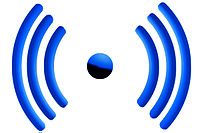History of Computers - Wireless Networks
This page created by: Max Susman
Wireless Networks, commonly known as Wi-Fi, are any type of wireless connections used by home computers, wireless internet, and video games etc. Invented in 1991 by NCR Corporation/AT&T in Nieuwegein, the Netherlands[1]. Inventor Vic Hayes is considered to be the "father of WiFi". The use of Wi-Fi has become increasingly widespread and popular in the past few years.
Contents
Overview

|
| The universal symbol indicating a Wi-Fi connection is accessible from a given location. |
History of WiFi
The first wireless internet service was developed in 1991 by NCR Corporation/AT&T's Vic Hayes. The first wireless products, initially meant and designed for cashiers, was called WaveLAN. This wireless service could transfer data around 1 Mbps/2 Mbps [1]. This technology would not exist however unless the Federal Communications Commission (FCC) had not opened up several bands of wireless spectrum, allowing them to be used without a government license [2]. In July 1999, Apple introduced the first wireless networking service for computers. The AirPort was the first card that allowed laptops to pick up wireless signals. Wi-Fi was boosted by the growing popularity of high-speed broadband internet connections in the home; it is the easiest way to enable several computers to share a broadband link. To this day, Wi-Fi's main use is in home networking[2]. Wireless Networking technology advances with leaps and bounds every year.
What is Wi-Fi?
Wi-Fi is a wireless signal which allows computers to connect and exchange data with one another, now at blistering speeds. Wi-Fi capabilities are standard in most laptops produced today. Public Wi-Fi spots have been developed over the years as well, making accessing the internet possible nearly anywhere.
Significance to the History of Computers
Wireless Networks are significant to the history of computers because it enables fast, long distance networking to many computers without the need of any cables. Also, wireless networking allows mobile computers, cell phones, and smart phones to access the internet almost anywhere. As Wi-Fi has gained popularity, around 40 United States cities have begun to offer free Wi-Fi service to an entire populous[3]. World wide Wi-Fi using satellites is under development and being taken advantage of now by some service providers.
References
- ↑ 1.0 1.1 http://www.wilcorpinc.com/wifi_history.htm
- ↑ 2.0 2.1 http://www.coe.montana.edu/ee/rwolff/EE580/history_of_wifi.htm
- ↑ http://en.wikipedia.org/wiki/Municipal_wireless_network#United_States